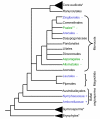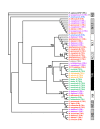TIR-NBS-LRR genes are rare in monocots: evidence from diverse monocot orders
- PMID: 19785756
- PMCID: PMC2763876
- DOI: 10.1186/1756-0500-2-197
TIR-NBS-LRR genes are rare in monocots: evidence from diverse monocot orders
Abstract
Background: Plant resistance (R) gene products recognize pathogen effector molecules. Many R genes code for proteins containing nucleotide binding site (NBS) and C-terminal leucine-rich repeat (LRR) domains. NBS-LRR proteins can be divided into two groups, TIR-NBS-LRR and non-TIR-NBS-LRR, based on the structure of the N-terminal domain. Although both classes are clearly present in gymnosperms and eudicots, only non-TIR sequences have been found consistently in monocots. Since most studies in monocots have been limited to agriculturally important grasses, it is difficult to draw conclusions. The purpose of our study was to look for evidence of these sequences in additional monocot orders.
Findings: Using degenerate PCR, we amplified NBS sequences from four monocot species (C. blanda, D. marginata, S. trifasciata, and Spathiphyllum sp.), a gymnosperm (C. revoluta) and a eudicot (C. canephora). We successfully amplified TIR-NBS-LRR sequences from dicot and gymnosperm DNA, but not from monocot DNA. Using databases, we obtained NBS sequences from additional monocots, magnoliids and basal angiosperms. TIR-type sequences were not present in monocot or magnoliid sequences, but were present in the basal angiosperms. Phylogenetic analysis supported a single TIR clade and multiple non-TIR clades.
Conclusion: We were unable to find monocot TIR-NBS-LRR sequences by PCR amplification or database searches. In contrast to previous studies, our results represent five monocot orders (Poales, Zingiberales, Arecales, Asparagales, and Alismatales). Our results establish the presence of TIR-NBS-LRR sequences in basal angiosperms and suggest that although these sequences were present in early land plants, they have been reduced significantly in monocots and magnoliids.
Figures




Similar articles
-
Analysis of TIR- and non-TIR-NBS-LRR disease resistance gene analogous in pepper: characterization, genetic variation, functional divergence and expression patterns.BMC Genomics. 2012 Sep 21;13:502. doi: 10.1186/1471-2164-13-502. BMC Genomics. 2012. PMID: 22998579 Free PMC article.
-
Isolation of TIR and non-TIR NBS--LRR resistance gene analogues and identification of molecular markers linked to a powdery mildew resistance locus in chestnut rose (Rosa roxburghii Tratt).Theor Appl Genet. 2005 Sep;111(5):819-30. doi: 10.1007/s00122-005-0002-7. Epub 2005 Oct 18. Theor Appl Genet. 2005. PMID: 16075209
-
Isolation, genetic variation and expression of TIR-NBS-LRR resistance gene analogs from western white pine ( Pinus monticola Dougl. ex. D. Don.).Mol Genet Genomics. 2003 Dec;270(5):432-41. doi: 10.1007/s00438-003-0940-1. Epub 2003 Oct 28. Mol Genet Genomics. 2003. PMID: 14586641
-
Identification and expression profiling analysis of NBS-LRR genes involved in Fusarium oxysporum f.sp. conglutinans resistance in cabbage.3 Biotech. 2019 May;9(5):202. doi: 10.1007/s13205-019-1714-8. Epub 2019 May 4. 3 Biotech. 2019. PMID: 31065502 Free PMC article. Review.
-
Plant NBS-LRR proteins in pathogen sensing and host defense.Nat Immunol. 2006 Dec;7(12):1243-9. doi: 10.1038/ni1410. Nat Immunol. 2006. PMID: 17110940 Free PMC article. Review.
Cited by
-
Genome survey of resistance gene analogs in sugarcane: genomic features and differential expression of the innate immune system from a smut-resistant genotype.BMC Genomics. 2019 Nov 6;20(1):809. doi: 10.1186/s12864-019-6207-y. BMC Genomics. 2019. PMID: 31694536 Free PMC article.
-
Genome sequencing of the high oil crop sesame provides insight into oil biosynthesis.Genome Biol. 2014 Feb 27;15(2):R39. doi: 10.1186/gb-2014-15-2-r39. Genome Biol. 2014. PMID: 24576357 Free PMC article.
-
The Role of Plant Transcription Factors in the Fight against Plant Viruses.Int J Mol Sci. 2023 May 8;24(9):8433. doi: 10.3390/ijms24098433. Int J Mol Sci. 2023. PMID: 37176135 Free PMC article. Review.
-
Convergent Loss of an EDS1/PAD4 Signaling Pathway in Several Plant Lineages Reveals Coevolved Components of Plant Immunity and Drought Response.Plant Cell. 2020 Jul;32(7):2158-2177. doi: 10.1105/tpc.19.00903. Epub 2020 May 14. Plant Cell. 2020. PMID: 32409319 Free PMC article.
-
Diversity and Evolution of NLR Genes in Citrus Species.Biology (Basel). 2024 Oct 14;13(10):822. doi: 10.3390/biology13100822. Biology (Basel). 2024. PMID: 39452131 Free PMC article.
References
Grants and funding
LinkOut - more resources
Full Text Sources
Research Materials
Miscellaneous

